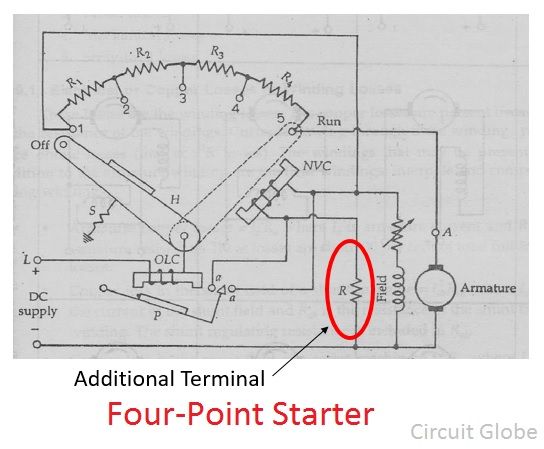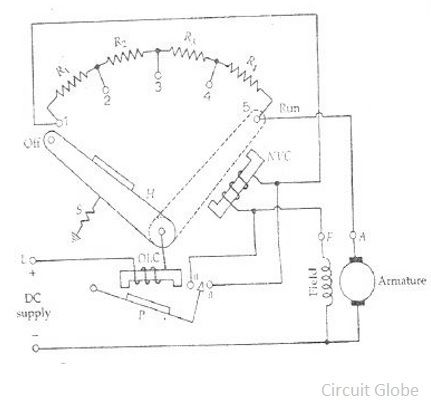The starter is a device which is used to start and run the motor. The most significant difference between the three point and the four-point starter is that in three-point starter the no voltage coil (NVC) is connected in series with the field winding whereas in four-point starter the NVC is directly connected to the supply voltage.
The no voltage coil (NVC) is a type of relay used for switching off the motor when the supply is decreased or cut-off. In the three-point starter, the NVC is placed in series with the field winding, and thus current is equally distributed among the NVC and the field winding.
In the four-point starter, the NVC is placed in parallel with the field winding. Thus, the value of current is different both for the NVC and the field winding. The variation in speed of the motor varies their field current. But with the parallel connection of the no voltage coil and the field winding the current passes through the NVC is not affected. This happens because the circuit of NVC and field winding are independent of each other.
Content: Three-Point Vs Four-point starter
Comparison Chart
| Basis for Comparison | Three-point Starter | Four Point Starter |
|---|---|---|
| Definition | The starter which uses the three terminals for starting the motor. | The four-point starter uses the four terminals for acceleration of motor. |
| Terminals | Armature terminal, field terminal and the Line terminal. | Armature terminal, Field terminal, Line terminal and the additional terminal that directly connects the supply to the no voltage coil (NVC). |
| No Volts Coil (NVC) | Connects in series with the field coil. | Connects in parallel with the field coil. |
Definition of Three-point-starter
The figure below shows the three-point dc shunt starter. The starter uses the resistance for limiting the starting current. The line terminal, field terminal and the armature terminal are the three points of the starter. The line terminal is connected to the positive phase of the supply. The armature terminal connected to the armature winding and the field terminal is connected to their field winding. Because of the three terminals, the starter is named as the three-point starter.
The starter consists two protective devices, i.e., the overload trip coil and the no-voltage coil. The overvoltage coil consists the armature current. When the value of current increases from the limited value then the OLC closes the contact.
Definition of Four Point Starter
The connection diagram of the three-point starter is shown in the figure below. The construction of the three-point starter is similar to the four-point starter. The only difference in their construction is that the holding coil is disconnected from the field winding and is directly connected to the line terminal along with the current limiting resistor R in series.
Key Differences Between the Three-point and Four-point Starter
- The starter which consists three terminals is known as the three-point starter. The four-point starter consists four terminals and hence called the four-point starter.
- The armature, field and line are the terminals of the three-point starter. Whereas in four-point starter along with the armature, field and line terminal one additional terminal is added which connected the no voltage coil parallel with the shunt field winding.
- In the three-point starter, the no-voltage coil (NVC) is connected in series with the field winding. Whereas in four-point starter the no-voltage winding is connected in parallel with the field winding.
Conclusion
The three-point and four-point starter both are similar in construction. But in three-point starter when the speed of the motor varies then the current passes through the field coil and this current affects the no-voltage coil. The four-point starter is designed for reducing the problem.


Brief information given. Thank you
Thank you for this information of 3 point and 4 point starter